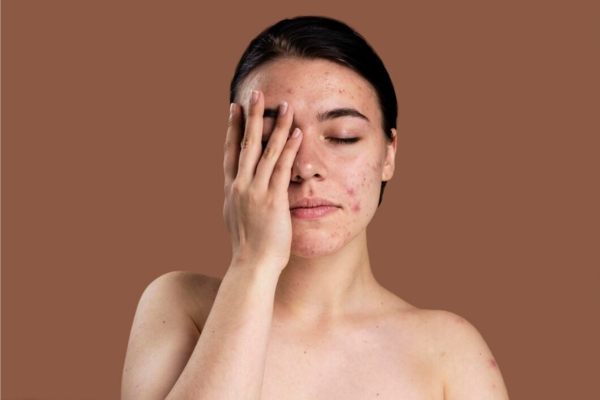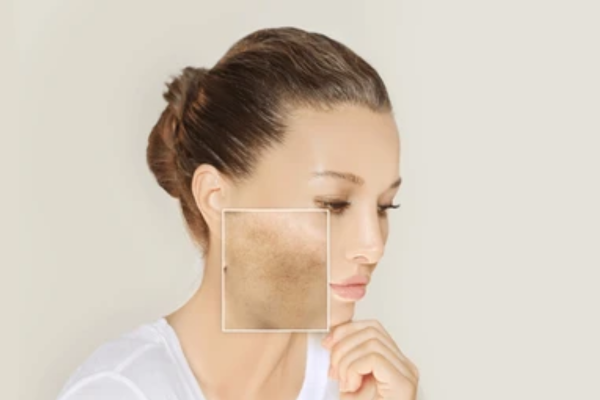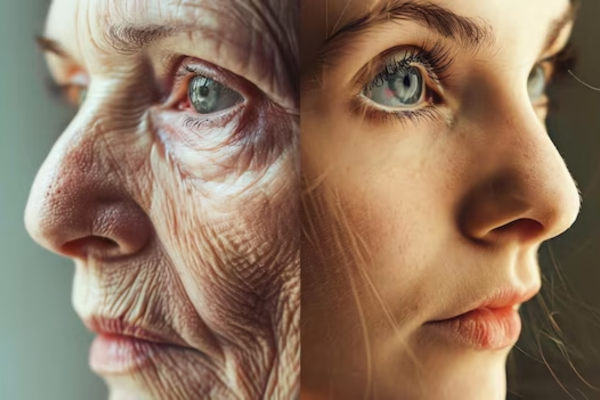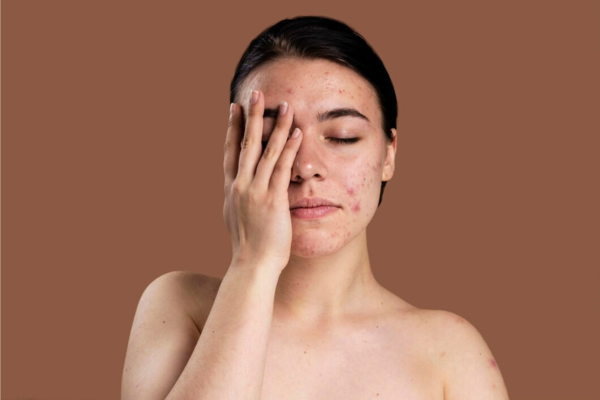
Acne & Acne Scars
Acne is one of the most prevalent skin conditions, affecting millions of individuals globally. It primarily occurs during adolescence but can persist into adulthood.
Characterized by the presence of pimples, blackheads, whiteheads, cysts, and nodules, acne can significantly impact an individual’s self-esteem and quality of life. Acne scars, the aftermath of severe acne, can leave lasting marks on the skin, further complicating the emotional and physical toll of the condition.
Possible Causes of Acne
- Hormonal Changes: During puberty, hormones called androgens increase, causing the sebaceous glands to enlarge and produce more sebum. Hormonal changes related to pregnancy and the use of oral contraceptives can also affect sebum production. Similarly, low levels of androgens circulating in the blood of women and men can worsen acne.
- Excess Oil Production: The overproduction of oil (sebum) by the skin’s sebaceous glands is a primary cause of acne. Excessive oil can clog pores, leading to the formation of acne lesions.
- Clogged Hair Follicles: When dead skin cells and excess oil accumulate, they can clog hair follicles. These clogged follicles can become inflamed, leading to the development of acne.
- Bacteria: Propionibacterium acnes (P. acnes) is a bacterium that naturally lives on the skin. When it grows excessively in clogged hair follicles, it can cause inflammation and lead to more severe acne lesions.
- Diet: Certain dietary factors, including dairy products and carbohydrate-rich foods like bread, bagels, and chips, may trigger acne. However, this relationship remains controversial, and more research is needed to understand the connection fully.
- Stress: While stress does not cause acne directly, it can exacerbate the condition by prompting the body to produce more androgens, which stimulate oil glands and hair follicles.
- Medications: Some medications, including corticosteroids, androgens, and lithium, can exacerbate acne.
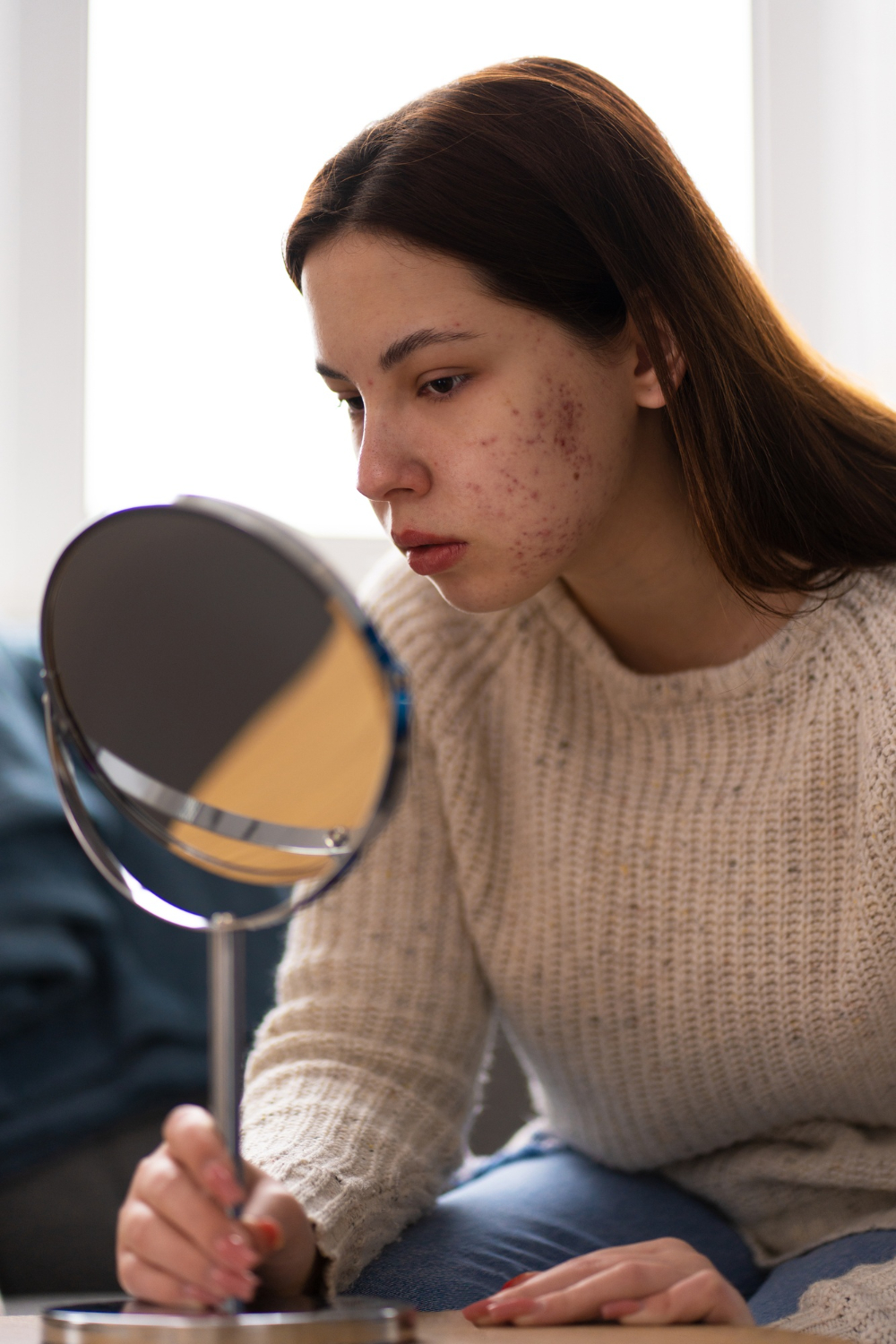
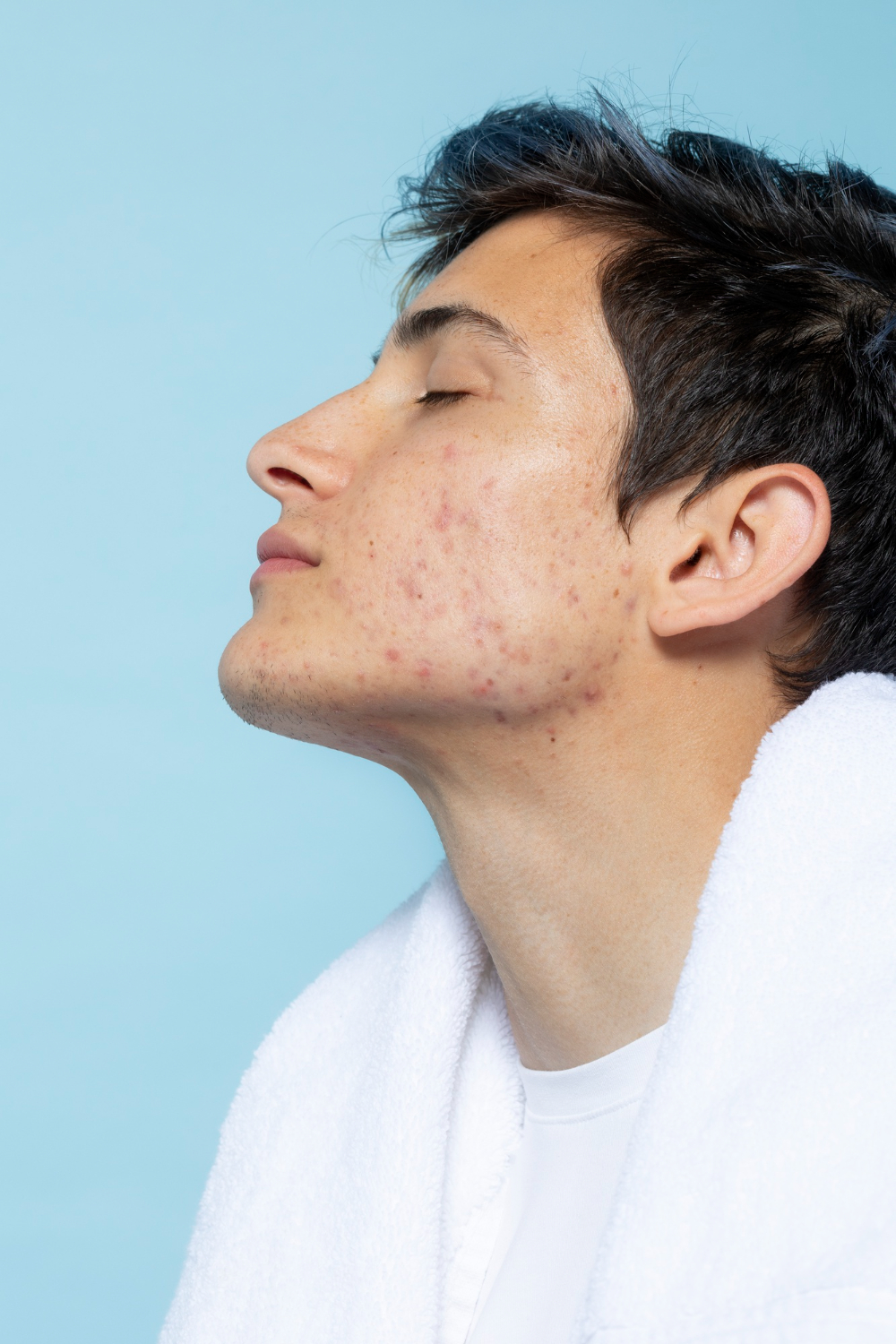
Types of Acne
- Whiteheads (Closed Comedones): These are clogged hair follicles covered by a thin layer of skin, appearing as small white bumps.
- Blackheads (Open Comedones): These occur when the clogged hair follicles open to the surface and darken, due to oxidation.
- Papules: Small red, raised bumps that are inflamed.
- Pustules: Similar to papules but contain pus, making them look like a whitehead surrounded by red skin.
- Nodules: Large, painful, solid lumps beneath the skin’s surface.
- Cysts: Pus-filled lumps beneath the skin, which can cause scars.
Types of Acne Scars
- Atrophic Scars: These are the most common type of acne scars, resulting from a loss of tissue. They include:
- Ice Pick Scars: Deep, narrow, pitted scars.
- Boxcar Scars: Broad depressions with sharply defined edges.
- Rolling Scars: Broad depressions with sloping edges.
- Hypertrophic Scars: Raised scars that develop when the body produces too much collagen as acne wounds heal.
- Keloid Scars: Similar to hypertrophic scars but grow much larger than the original wound.
Who is More at Risk of Acne?
- Teenagers and Young Adults: Hormonal changes during puberty significantly increase oil production, leading to clogged pores and acne. This age group is more likely to experience severe acne, which can lead to scarring if not treated properly.
- Genetic Predisposition: A family history of acne can increase the likelihood of developing acne. Genetic factors can also influence skin type, oil production, and the inflammatory response, all of which contribute to acne.
- Hormonal Changes and Imbalances: Hormonal fluctuations due to menstrual cycles, pregnancy, or conditions like polycystic ovary syndrome (PCOS) can trigger acne in women. Hormone-related acne is often located on the lower face, jawline, and neck.
- Individuals with Oily Skin: Excessive oil production can lead to clogged pores and acne. People with naturally oily skin are more prone to developing both acne and post-acne scars.
- People with High Stress Levels: Stress increases the production of hormones like cortisol, which can exacerbate acne. Chronic stress can also impede the healing process, increasing the risk of scarring.
- Improper Skincare and Makeup Use: Using comedogenic (pore-clogging) skincare and makeup products can contribute to acne. Improper skincare routines, such as not cleansing the face properly, can worsen acne and increase the risk of scarring.
- Dietary Factors: Diets high in refined sugars, dairy products, and processed foods can contribute to acne development. Certain foods may trigger inflammation and increase the severity of acne, leading to a higher risk of scarring.
- Certain Medications: Some medications, such as corticosteroids, lithium, and certain birth control pills, can trigger or worsen acne. Individuals taking these medications should monitor their skin and seek dermatological advice if acne develops.
- Environmental Factors: High humidity and pollution can exacerbate acne by clogging pores. Exposure to harsh weather conditions and sweating can also contribute to acne flare-ups.
- Improper Handling of Acne: Picking, squeezing, or popping pimples can lead to skin trauma and increase the risk of scarring. Using harsh or abrasive treatments can worsen inflammation and contribute to acne scars.
- Individuals with Certain Medical Conditions: Conditions like diabetes or autoimmune diseases can impair skin healing, increasing the risk of scarring. Individuals with these conditions should seek specialized dermatological care for acne management.
Understanding who is more prone to acne and acne scars can help in taking proactive steps to manage and prevent these skin concerns. It is crucial to seek guidance from a dermatologist for personalized skincare advice and effective treatment options.
Importance of Visiting DermaLinks to consult with our Dermatologists
- Accurate Diagnosis: Dermatologists can accurately diagnose the type and severity of acne and recommend the most effective treatment plan tailored to the individual’s skin type and condition.
- Comprehensive Treatment Options: Dermatologists can provide a variety of treatment options, including topical and oral medications, hormonal treatments, and physical procedures like chemical peels, microdermabrasion, laser therapy, and light therapy.
- Preventing Scarring: Early and effective treatment can prevent acne from progressing to the point where it causes scarring. Dermatologists can also provide treatments specifically aimed at reducing the appearance of existing scars, such as microneedling, laser resurfacing, and fillers.
- Managing Psychological Impact: Acne and acne scars can significantly impact an individual’s self-esteem and mental health. Dermatologists can offer support and, if necessary, refer patients to mental health professionals.
- Tailored Skincare Regimens: Dermatologists at DermaLinks can recommend skincare products and routines that suit the patient’s skin type and condition, helping to manage acne and improve overall skin health. Preventive measures & skincare tips are effective for post treatment maintenance.
Acne and acne scars are common skin conditions that can have profound physical and psychological impacts. Understanding the underlying causes, preventive measures, and available treatments is crucial for effective management. Visiting Dermatologist at DermaLinks is essential for accurate diagnosis, personalized treatment plans, and the prevention of long-term scarring. With ongoing research and advancements in dermatological treatments, individuals suffering from acne can look forward to more effective and tailored solutions, improving their skin health and quality of life
Need Any Help
Request A Consultation And Price Estimate
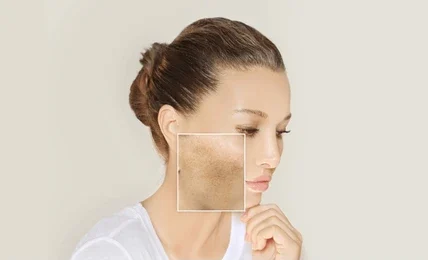
Pigmentary disorders & Melasma
Pigmentary disorders encompass a range of conditions that affect the colour of the skin, leading to either hyperpigmentation (darkening of the skin) or hypopigmentation (lightening of the skin). Melasma is a common type of hyperpigmentation, characterized by dark, discoloured patches, typically on the face. Understanding the causes and effective treatments for pigmentary disorders, including melasma, is essential for managing these conditions and improving skin appearance.
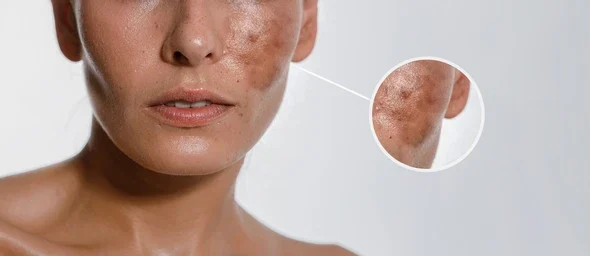
Possible Causes of Pigmentary Disorders
- Genetics: Family history can play a significant role in the development of pigmentary disorders.
- Sun Exposure: Ultraviolet (UV) light can cause pigmentation changes, leading to conditions such as melasma and sunspots.
- Hormonal Changes: Hormonal fluctuations, such as those during pregnancy or due to contraceptive use, can trigger pigmentation changes.
- Inflammation: Post-inflammatory hyperpigmentation (PIH) occurs after skin injuries or inflammatory conditions like acne.
- Medications: Certain medications can cause pigmentation changes as a side effect.
- Cosmetics and Skin Care Products: Certain cosmetics and skin care products can irritate the skin and worsen melasma.
Symptoms and Diagnosis
- Symptoms:
- Hyperpigmentation: Dark patches or spots on the skin, which are characteristic of both melasma and other pigmentary disorders.
- Hypopigmentation: Light patches or loss of skin color, common in other pigmentary disorders.
- Uneven Skin Tone: Irregular pigmentation leading to an uneven complexion.
- Melasma Specific Symptoms: Brown or grey-brown patches, typically on the face, including the cheeks, forehead, bridge of the nose, and upper lip. These patches often appear symmetrically on both sides of the face and do not usually cause itching or discomfort.
- Diagnosis: Dermatologists at DermaLinks diagnose pigmentary disorders and melasma through a physical examination, medical history review, and sometimes a skin biopsy or Wood’s lamp examination to determine the extent and depth of pigmentation.
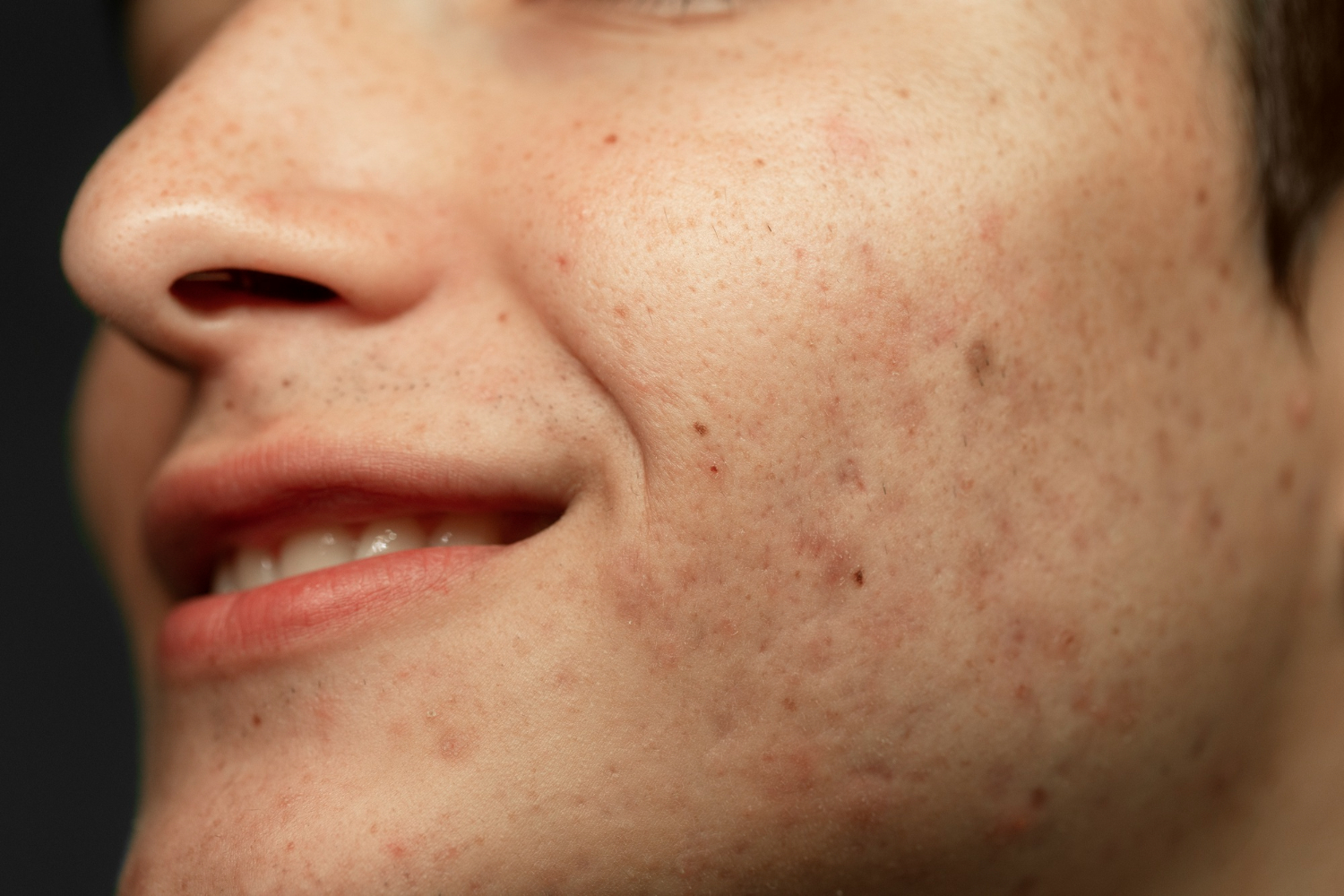
Importance of Visiting a Dermatologist at DermaLinks
- Accurate Diagnosis: Dermatologists at DermaLinks can accurately diagnose pigmentary disorders and differentiate them from other skin conditions.
- Comprehensive Treatment Plans: Dermatologists can develop individualized treatment plans based on the type and severity of the pigmentation disorder.
- Management of Recurrence: Dermatologists can provide strategies to prevent pigmentary disorders and melasma from recurring.
- Guidance on Skincare: Dermatologists can offer advice on managing skin symptoms and preventing flare-ups and preventive skin care.
Types of Acne Scars
- Atrophic Scars: These are the most common type of acne scars, resulting from a loss of tissue. They include:
- Ice Pick Scars: Deep, narrow, pitted scars.
- Boxcar Scars: Broad depressions with sharply defined edges.
- Rolling Scars: Broad depressions with sloping edges.
- Hypertrophic Scars: Raised scars that develop when the body produces too much collagen as acne wounds heal.
- Keloid Scars: Similar to hypertrophic scars but grow much larger than the original wound.
Common Treatments for Pigmentary Disorders and Melasma
- Topical Treatments:
– Hydroquinone: A skin-lightening agent for hyperpigmentation.
– Tretinoin and Corticosteroids: Often used in combination with hydroquinone for better efficacy.
– Azelaic Acid and Kojic Acid: Alternatives for reducing pigmentation.
– Tranexamic Acid: Used topically to reduce pigmentation, particularly in melasma.
– Calcineurin Inhibitors: For treating hypopigmentation conditions like vitiligo. - Chemical Peels:
– Glycolic Acid Peels: To exfoliate the skin and reduce pigmentation.
– Salicylic Acid Peels: For deeper exfoliation and pigment reduction. - Laser and Light Therapies:
– Fractional Lasers: To target pigmentation and stimulate collagen production.
– Intense Pulsed Light (IPL): To reduce pigmentation and improve skin tone. - Oral Medications:
– Tranexamic Acid: For treating melasma and other hyperpigmentation disorders.
– Antioxidants: Supplements to support overall skin health. - Lifestyle and Home Remedies:
– Sun Protection: Using broad-spectrum sunscreen with high SPF to protect against UV rays.
– Gentle Skincare: Using non-irritating, fragrance-free products.
– Healthy Diet: Consuming a balanced diet rich in vitamins and antioxidants to support skin health.
Pigmentary disorders, including melasma, encompass a range of conditions that can significantly impact quality of life. Understanding their causes and effective treatments is essential for managing symptoms and improving skin appearance. Visiting a dermatologist ensures accurate diagnosis, personalized treatment plans, and access to advanced treatments. With ongoing research and advancements in medical therapies, the future holds promise for improved management of pigmentary disorders and melasma
Need Any Help
Request A Consultation And Price Estimate
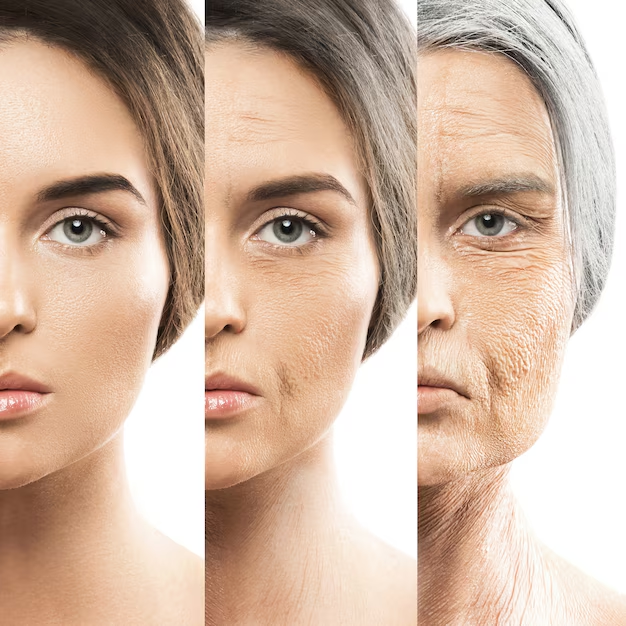
Signs of Ageing
Crows feet Forehead lines Smile lines Gummy smile Bunny lines Droopy lips
Signs of aging such as crows feet, forehead lines, smile lines, gummy smile, bunny lines, and droopy lips are common cosmetic concerns that develop with age. These visible changes in facial appearance can impact self-esteem and overall appearance. Understanding the underlying causes, preventive measures, and seeking dermatological advice are essential for managing and reducing these signs effectively.
Possible Causes
Several factors contribute to the development of signs of aging:
- Loss of Skin Elasticity: Aging leads to a gradual loss of collagen and elastin fibers in the skin, causing it to become thinner, drier, and less elastic. This loss of elasticity contributes to the formation of wrinkles and fine lines, such as crows feet around the eyes.
- Repeated Facial Expressions: Facial lines, including forehead lines and smile lines, develop as a result of repeated facial movements and expressions over time. For example, squinting, frowning, and smiling can create creases in the skin.
- Sun Damage: Exposure to ultraviolet (UV) radiation from the sun accelerates skin aging and contributes to the breakdown of collagen fibers. UV rays penetrate deep into the skin, causing damage that manifests as wrinkles, sun spots, and sagging skin.
- Genetic Factors: Genetic predisposition plays a role in how quickly signs of aging appear. Some individuals may be genetically predisposed to developing deeper wrinkles or more pronounced facial lines.
Symptoms and Diagnosis
Signs of aging vary depending on the area of the face:
- Crows Feet: Fine lines that radiate outward from the corners of the eyes, often caused by repeated smiling or squinting.
- Forehead Lines: Horizontal lines that appear across the forehead due to raising the eyebrows or expressions of surprise.
- Smile Lines: Nasolabial folds that extend from the sides of the nose to the corners of the mouth, becoming more prominent with age.
- Gummy Smile: Excessive display of gum tissue when smiling, caused by hyperactive upper lip muscles.
- Bunny Lines: Diagonal lines that appear on the nose when smiling or scrunching the nose.
- Droopy Lips: Loss of lip volume and definition, leading to sagging or thinning of the lips.
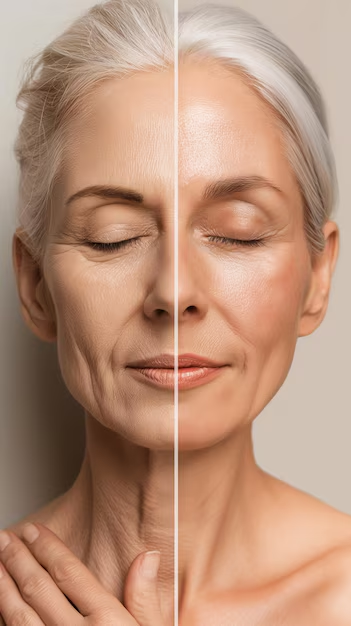
Diagnosis is typically based on a visual assessment by a dermatologist, who evaluates the severity and distribution of facial lines and wrinkles.
Importance of Visiting DermaLinks
- Customized Treatment Plans: Dermatologists offer personalized treatment plans tailored to address specific signs of aging and individual aesthetic goals. Treatment options may include botulinum toxin injections (Wrinkle remover) to relax facial muscles and reduce dynamic wrinkles, dermal fillers (such as hyaluronic acid fillers) to restore volume and smooth out wrinkles, chemical peels to exfoliate and rejuvenate the skin, and laser therapies to improve skin texture and stimulate collagen production.
- Professional Guidance: Dermatologists specialize in cosmetic procedures and treatments designed to minimize signs of aging effectively. They provide expertise in treatment selection, ensuring safe and optimal outcomes for patients.
- Safety and Monitoring: Dermatologists ensure safe administration of cosmetic procedures and monitor skin response to treatments. They provide guidance on post-treatment care and manage potential side effects to minimize risks.
- Long-term Care: Regular visits to a dermatologist are essential for maintaining skin health and managing signs of aging over time. Dermatologists offer advice on skincare routines, sun protection measures, and lifestyle modifications to support skin rejuvenation and slow down the aging process.
Summary
Signs of aging, such as crows feet, forehead lines, smile lines, gummy smile, bunny lines, and droopy lips, are cosmetic concerns that develop with age due to factors such as loss of skin elasticity, repeated facial expressions, sun damage, and genetic predisposition. Visiting a dermatologist is crucial for personalized treatment plans, safe and effective cosmetic procedures, and long-term management to maintain youthful skin appearance and enhance self-confidence.
Need Any Help
Request A Consultation And Price Estimate

Hyperhidrosis
Hyperhidrosis is a condition characterized by excessive sweating beyond what is necessary for thermoregulation. It can affect various body areas, such as the palms, soles, underarms, and face. Understanding the causes and effective treatments for hyperhidrosis is essential for managing this often-distressing condition.
Possible Causes of Hyperhidrosis
- Primary Hyperhidrosis: The most common type, often with no identifiable cause, thought to result from overactive sweat glands.
- Secondary Hyperhidrosis: Caused by underlying medical conditions such as diabetes, thyroid disorders, infections, or certain medications.
- Genetics: Family history can play a role in primary hyperhidrosis.
Symptoms and Diagnosis
- Excessive Sweating: Sweating that is disproportionate to the temperature or level of activity.
- Sweating in Specific Areas: Localized to specific areas like palms, soles, underarms, or face.
- Impact on Daily Activities: Difficulty holding objects, discomfort in social situations, and potential skin infections.
Diagnosis: Dermatologists diagnose hyperhidrosis through a physical examination and medical history review. Tests such as the starch-iodine test or gravimetric measurement may be used to assess sweat production.

Importance of Visiting DermaLinks
- Accurate Diagnosis: Dermatologists can distinguish between primary and secondary hyperhidrosis and identify any underlying conditions.
- Comprehensive Treatment Plans: Dermatologists can develop individualized treatment plans based on the severity and specific areas affected. The treatments options may include : Topical Treatments, Oral Medications, Injectable Treatments, Minimally invasive procedures, surgical treatments
- Access to Advanced Treatments: Dermatologists can provide access to advanced treatments such as botulinum toxin injections and microwave therapy.
- Guidance on Skincare: Dermatologists can offer advice on managing skin issues related to excessive sweating.
Summary
Hyperhidrosis is a condition characterized by excessive sweating, which can be primary or secondary to other medical conditions. Understanding its causes and effective treatments is essential for managing symptoms and improving quality of life. Visiting a dermatologist ensures accurate diagnosis, personalized treatment plans, and access to advanced treatments. With ongoing research and advancements in medical and minimally invasive therapies, the future holds promise for improved management of hyperhidrosis.

